Evaluating the Ageing Sensitivity of the Asphalt Binder via Distinct Ageing Methods
Abstract
:1. Introduction
2. Materials and Methods
2.1. Materials
2.2. Accelerated Ageing Methods
2.2.1. Ageing of Asphalt Binder
2.2.2. Ageing of Loose Asphalt Mixtures
2.3. Extraction and Recovery of Aged Binders
2.4. Testing Methods
2.4.1. Physical Properties
2.4.2. Rheological Properties
2.4.3. Chemical Properties
3. Results and Discussion
3.1. Penetration Test
3.2. Softening Point Test
3.3. Dynamic Viscosity Test
3.4. Performance Grading (PG)
3.5. Temperature Sweep Test
3.6. Binder Fast Characterisation Test (BTSV)
- Plate geometry: 25 mm;
- Gap: 1 mm;
- Constant shear stress: 500 ± 5 Pa;
- Test frequency: 1.59 Hz;
- Temperature range: 25 °C to 90 °C;
- Temperature increase rate: 1.2 °C/min.
3.7. Complex Viscosity
3.8. Fourier Transform Infrared (FTIR) Spectroscopy
3.9. Comparative Evaluation Based on the Ageing Sensitivity Index
4. Summary and Conclusions
Author Contributions
Funding
Data Availability Statement
Acknowledgments
Conflicts of Interest
References
- Ma, L.; Varveri, A.; Jing, R.; Erkens, S. Comprehensive review on the transport and reaction of oxygen and moisture towards coupled oxidative ageing and moisture damage of bitumen. Constr. Build. Mater. 2021, 283, 122632. [Google Scholar] [CrossRef]
- Mirwald, J.; Werkovits, S.; Camargo, I.; Maschauer, D.; Hofko, B.; Grothe, H. Investigating bitumen long-term-ageing in the laboratory by spectroscopic analysis of the SARA fractions. Constr. Build. Mater. 2020, 258, 119577. [Google Scholar] [CrossRef]
- Di Mino, G.; Vijayan, V.; Eskandarsefat, S.; Venturini, L.; Mantalovas, K. Investigating the Multi-Recyclability of Recycled Plastic-Modified Asphalt Mixtures. Infrastructures 2023, 8, 84. [Google Scholar] [CrossRef]
- Pazzini, M.; Tarsi, G.; Tataranni, P.; Lantieri, C.; Dondi, G. Mechanical Characterization of Thin Asphalt Overlay Mixtures with 100% Recycled Aggregates. Materials 2023, 16, 188. [Google Scholar] [CrossRef]
- Mantalovas, K.; Di Mino, G.; Jimenez Del Barco Carrion, A.; Keijzer, E.; Kalman, B.; Parry, T.; Lo Presti, D. European national road authorities and circular economy: An insight into their approaches. Sustainability 2020, 12, 7160. [Google Scholar] [CrossRef]
- Mantalovas, K.; Dunn, I.P.; Acuto, F.; Vijayan, V.; Inzerillo, L.; Di Mino, G. A Top-Down Approach Based on the Circularity Potential to Increase the Use of Reclaimed Asphalt. Infrastructures 2023, 8, 83. [Google Scholar] [CrossRef]
- Lu, X.; Isacsson, U. Effect of ageing on bitumen chemistry and rheology. Constr. Build. Mater. 2002, 16, 15–22. [Google Scholar] [CrossRef]
- Liu, Q.; Yu, B.; Cannone Falchetto, A.; Wang, D.; Liu, J.; Bo, W. Characterization and molecular mechanism of the thermal-oxidative gradient aging behavior in asphalt films. Measurement 2022, 199, 111567. [Google Scholar] [CrossRef]
- Guo, Y.; Tataranni, P.; Sangiorgi, C. The use of fibres in asphalt mixtures: A state of the art review. Constr. Build. Mater. 2023, 390, 131754. [Google Scholar] [CrossRef]
- Cavalli, M.C.; Zaumanis, M.; Mazza, E.; Partl, M.N.; Poulikakos, L.D. Effect of ageing on the mechanical and chemical properties of binder from RAP treated with bio-based rejuvenators. Compos. Part B Eng. 2018, 141, 174–181. [Google Scholar] [CrossRef]
- Prosperi, E.; Bocci, E. A review on bitumen aging and rejuvenation chemistry: Processes, materials and analyses. Sustainability 2021, 13, 6523. [Google Scholar] [CrossRef]
- Zhang, H.; Chen, Z.; Xu, G.; Shi, C. Evaluation of aging behaviors of asphalt binders through different rheological indices. Fuel 2018, 221, 78–88. [Google Scholar] [CrossRef]
- Ragni, D.; Ferrotti, G.; Lu, X.; Canestrari, F. Effect of temperature and chemical additives on the short-term ageing of polymer modi fi ed bitumen for WMA. Mater. Des. 2018, 160, 514–526. [Google Scholar] [CrossRef]
- Tauste, R.; Moreno-Navarro, F.; Sol-Sánchez, M.; Rubio-Gámez, M.C. Understanding the bitumen ageing phenomenon: A review. Constr. Build. Mater. 2018, 192, 593–609. [Google Scholar] [CrossRef]
- Leite, L.F.M.; Osmari, P.H.; Aragão, F.T.S. Rheological indexes for asphalt binders considering different aging conditions: Evaluation and correlations with performance. Constr. Build. Mater. 2022, 338, 127549. [Google Scholar] [CrossRef]
- Xu, S.; Wu, H.; Song, W.; Zhan, Y. Investigation of the aging behaviors of reclaimed asphalt. J. Clean. Prod. 2022, 356, 131837. [Google Scholar] [CrossRef]
- Miguel, J.; Crucho, L.; De Picado-santos, L.G.; Manuel, J.; Dias, S. The TEAGE ageing method for asphalt mixtures. Transp. Eng. 2020, 2, 100030. [Google Scholar] [CrossRef]
- Saleh, N.F.; Keshavarzi, B.; Yousefi, F.; Mocelin, D.; Elwardany, M.; Castorena, C.; Underwood, B.S.; Kim, Y.R. Effects of aging on asphalt mixture and pavement performance. Constr. Build. Mater. 2020, 258, 120309. [Google Scholar] [CrossRef]
- Kim, Y.R.; Castorena, C.; Elwardany, M.; Rad, F.Y.; Underwood, S.; Gundha, A.; Gudipudi, P.; Farrar, M.J.; Glaser, R.R. Long-Term Aging of Asphalt Mixtures for Performance Testing and Prediction; National Academies Press: Washington, DC, USA, 2017; ISBN 978-0-309-46863-3. [Google Scholar]
- Steiner, D.; Hofko, B.; Hospodka, M.; Handle, F.; Füssl, J.; Eberhardsteiner, L.; Blab, R.; Steiner, D.; Hofko, B.; Hospodka, M.; et al. Towards an optimised lab procedure for long-term oxidative ageing of asphalt mix specimen. Int. J. Pavement Eng. 2016, 17, 471–477. [Google Scholar] [CrossRef]
- Li, Y.; Feng, J.; Wu, S.; Chen, A.; Kuang, D.; Bai, T. Review of ultraviolet ageing mechanisms and anti-ageing methods for asphalt binders. J. Road Eng. 2022, 2, 137–155. [Google Scholar] [CrossRef]
- Xiao, F.; Amirkhanian, S.N.; Karakouzian, M.; Khalili, M. Rheology evaluations of WMA binders using ultraviolet and PAV aging procedures. Constr. Build. Mater. 2015, 79, 56–64. [Google Scholar] [CrossRef]
- Mouillet, V.; Farcas, F.; Sauger, J.; Chailleux, E. Study of UV rays effects on the evolution of bituminous mix behaviour. In Proceedings of the 6th Eurasphalt & Eurobitume Congress, Prague, Czech Republic, 1–3 June 2016. [Google Scholar]
- Zeng, W.; Wu, S.; Pang, L.; Chen, H.; Hu, J.; Sun, Y.; Chen, Z. Research on Ultra Violet (UV) aging depth of asphalts. Constr. Build. Mater. 2018, 160, 620–627. [Google Scholar] [CrossRef]
- Fallah, F.; Khabaz, F.; Kim, Y.; Reddy, S.; Haghshenas, H.F. Molecular dynamics modeling and simulation of bituminous binder chemical aging due to variation of oxidation level and saturate-aromatic-resin-asphaltene fraction. Fuel 2019, 237, 71–80. [Google Scholar] [CrossRef]
- Zhang, W.; Zou, L.; Jia, Z.; Wang, F.; Li, Y.; Shi, P. Effect of Thermo-Oxidative Ageing on Nano-Morphology of Bitumen. Appl. Sci. 2019, 9, 3027. [Google Scholar] [CrossRef]
- ANAS Gruppo FS Italiane. Capitolato Speciale di Appalto, Norme Tecniche per L’esecuzione del Contratto Parte 2; Pavimentazioni Stradali; ANAS Gruppo FS Italiane: Rome, Italy, 2021. [Google Scholar]
- EN 12607-1:2014; Bitumen and Bituminous Binders—Determination of the Resistance to Hardening under Influence of Heat and Air—Part 1: RTFOT Method. CEN: Brussels, Belgium, 2014.
- EN 14769:2012; Bitumen and Bituminous Binders—Accelerated Long-Term Ageing Conditioning by a Pressure Ageing Vessel (PAV). CEN: Brussels, Belgium, 2012.
- EN 12697-1:2020; Bituminous Mixtures—Test Methods—Part 1: Soluble Binder Content. CEN: Brussels, Belgium, 2020.
- EN 12697-3:2005; Bituminous Mixtures—Test Methods for Hot Mix Asphalt—Part 3: Bitumen Recovery: Rotary Evaporator. CEN: Brussels, Belgium, 2005.
- Celauro, C.; Teresi, R.; Dintcheva, N.T. Effect of Short-Term and UV Irradiation Aging on the Behaviour of SBS-Modified Bitumen. Sustainability 2022, 14, 6915. [Google Scholar] [CrossRef]
- EN 1426:2015; Bitumen and Bituminous Binders—Determination of Needle Penetration. CEN: Brussels, Belgium, 2015.
- Schwettmann, K.; Nytus, N.; Radenberg, M.; Stephan, D. Bitumen reuse: Physical and chemical approach to investigate the effectiveness of rejuvenators. Road Mater. Pavement Des. 2023, 24, 1130–1157. [Google Scholar] [CrossRef]
- EN 1427:2015; Bitumen and Bituminous Binders—Determination of the Softening Point—Ring and Ball Method. CEN: Brussels, Belgium, 2015.
- EN 13302:2018; Bitumen and Bituminous Binders—Determination of Dynamic Viscosity of Bituminous Binder Using a Rotating Spindle Apparatus. CEN: Brussels, Belgium, 2018; p. 16.
- EN 14770:2012; Bitumen and Bituminous Binders—Determination of Complex Shear Modulus and Phase Angle—Dynamic Shear Rheometer (DSR). CEN: Brussels, Belgium, 2012.
- EN 17643:2022; Bitumen and Bituminous Binders—Determination of Equi-Shear Modulus Temperature and Phase Angle Using a Dynamic Shear Rheometer (DSR)—BTSV Test. CEN: Brussels, Belgium, 2022.
- Clopotel, C.; Bahia, H. The effect of bitumen polar groups adsorption on mastics properties at low temperatures. Road Mater. Pavement Des. 2013, 14, 38–51. [Google Scholar] [CrossRef]
- Fritschy, G.; Papirer, E. Interactions between a bitumen, its components and model fillers. Fuel 1978, 57, 701–704. [Google Scholar] [CrossRef]

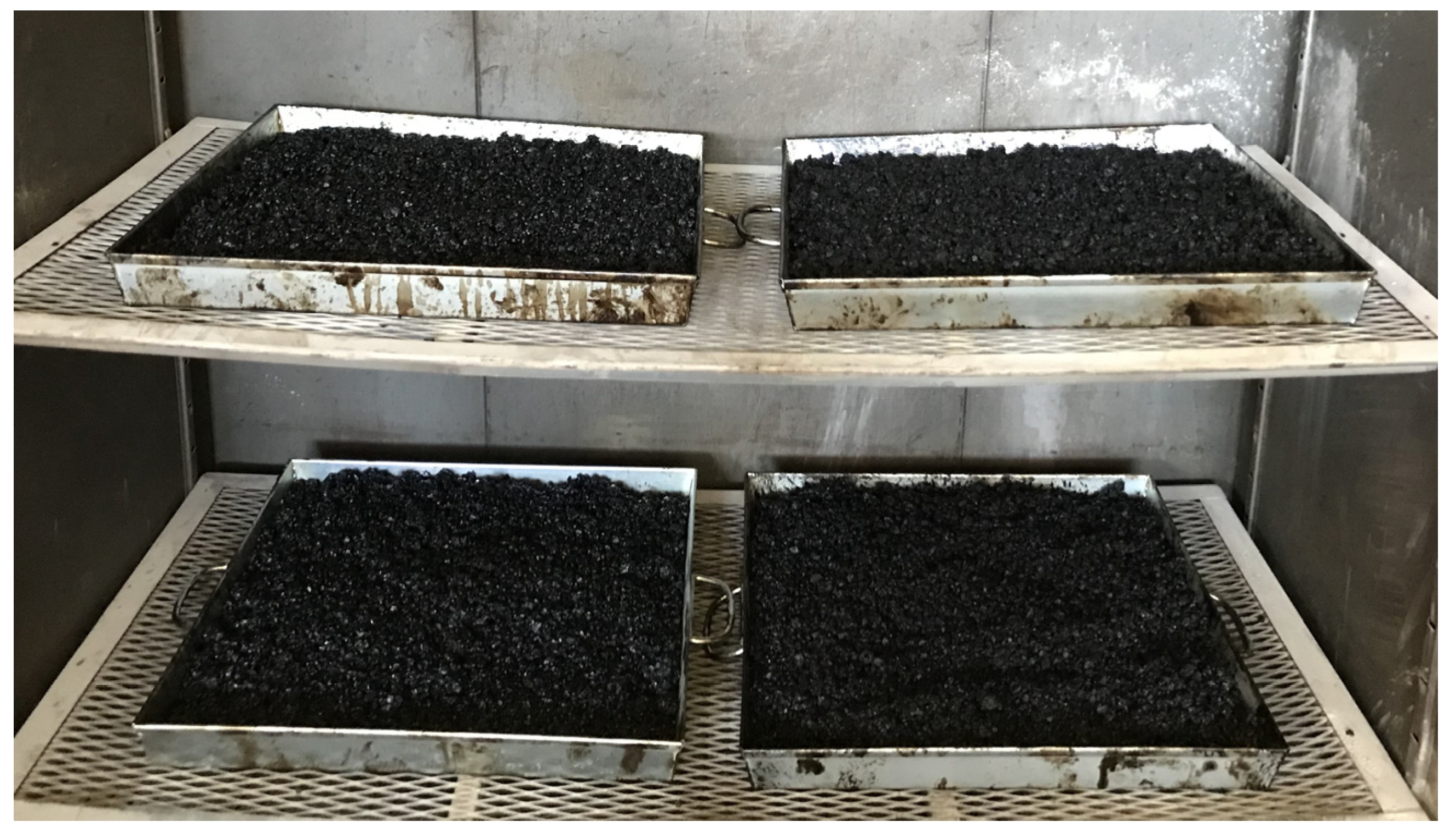
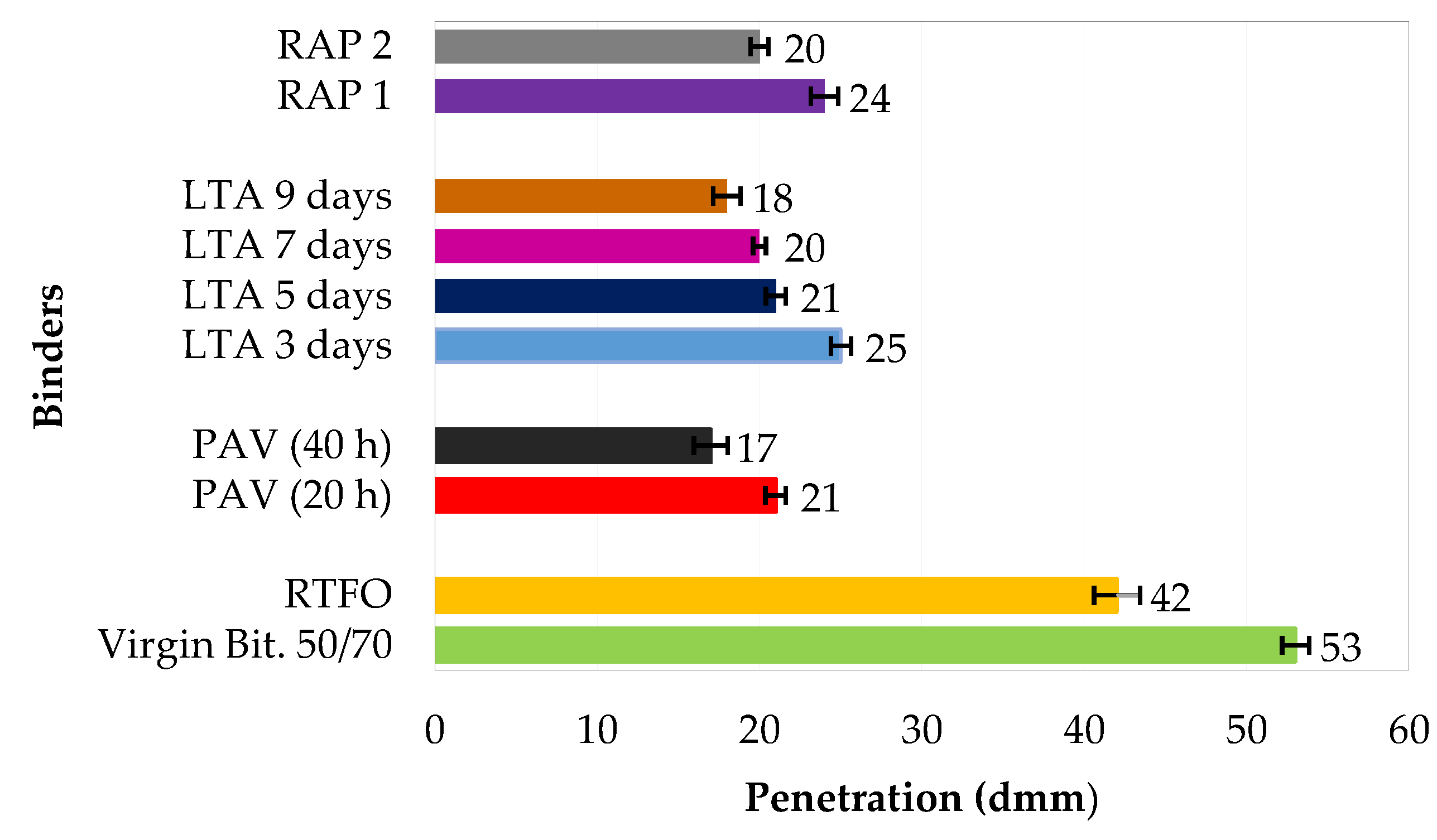
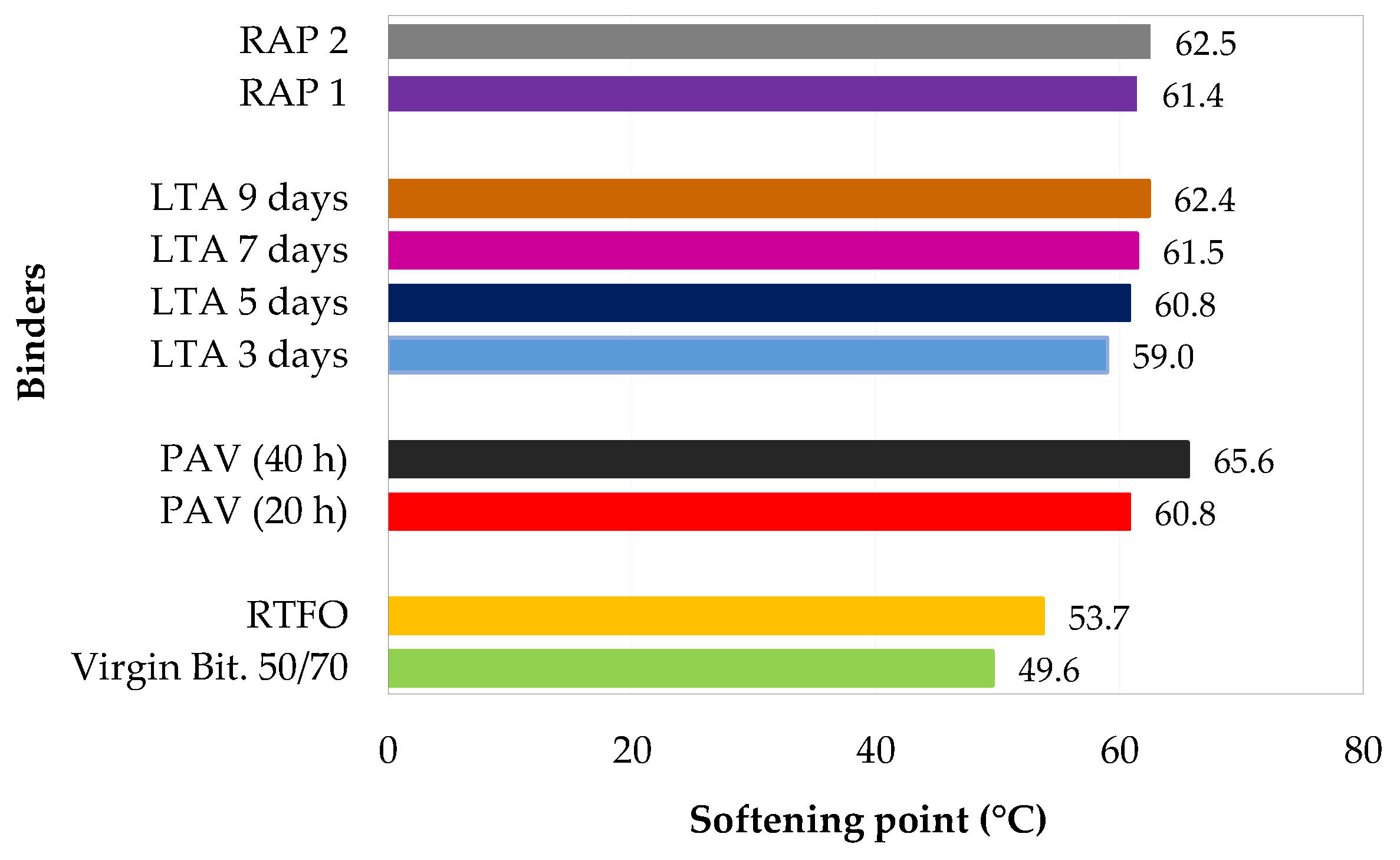
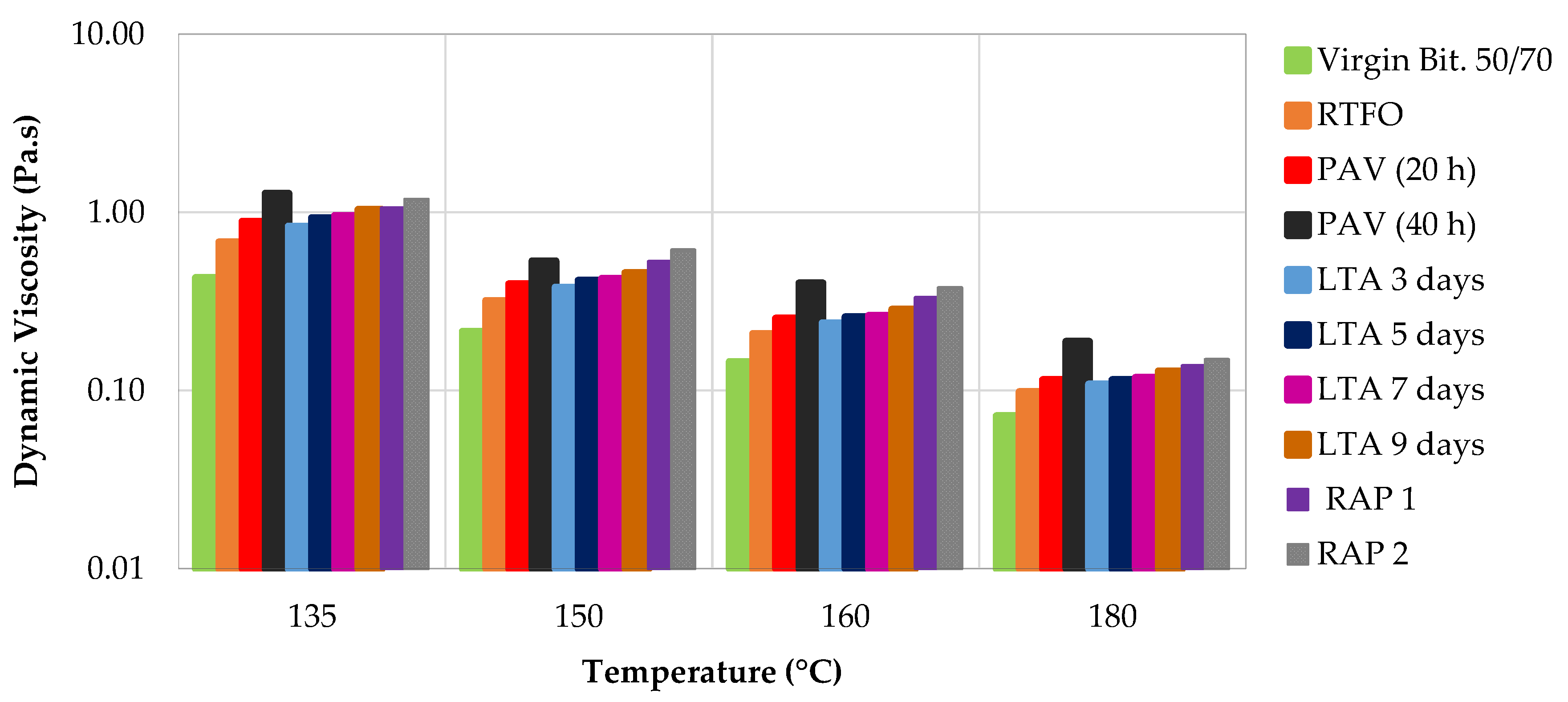
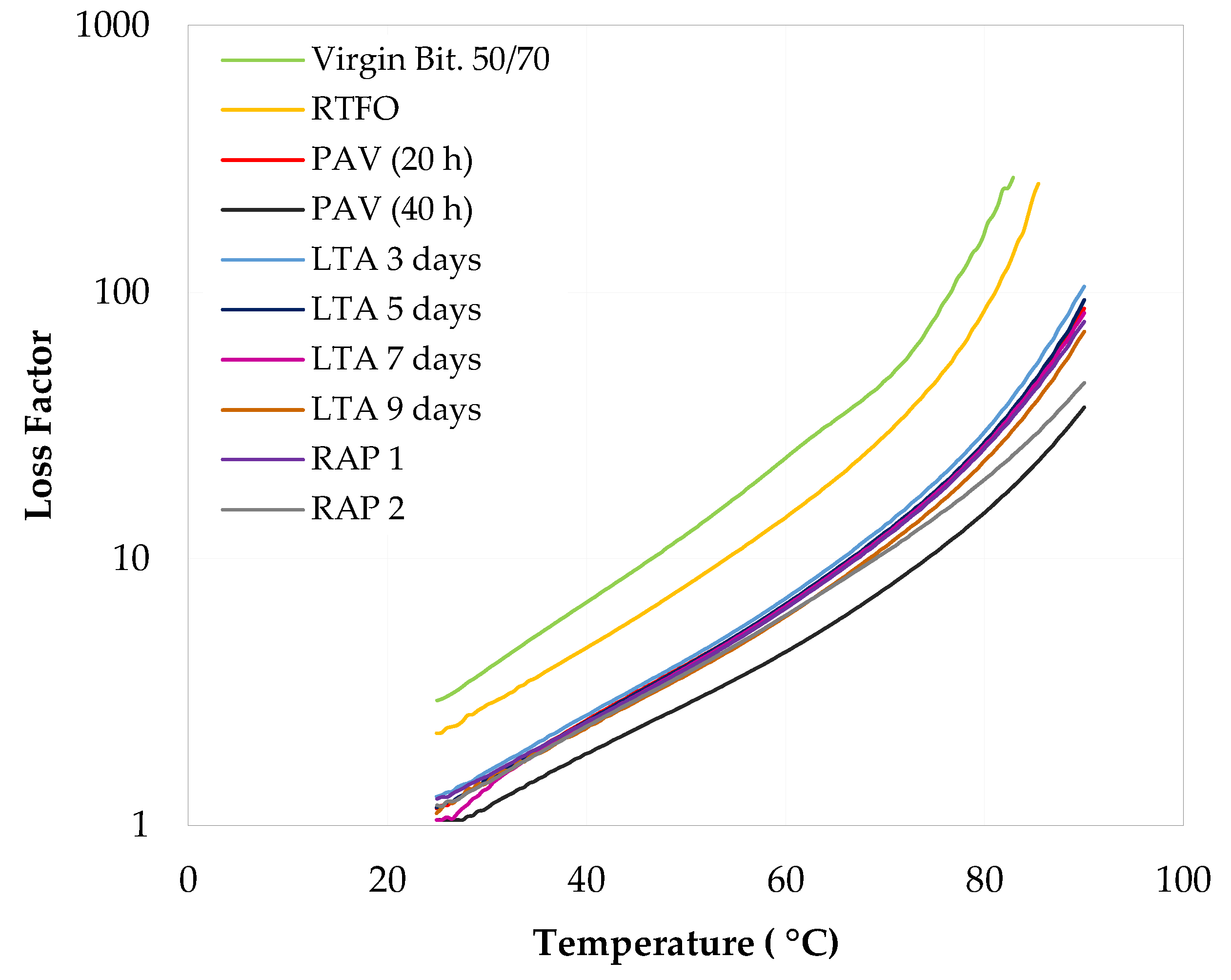

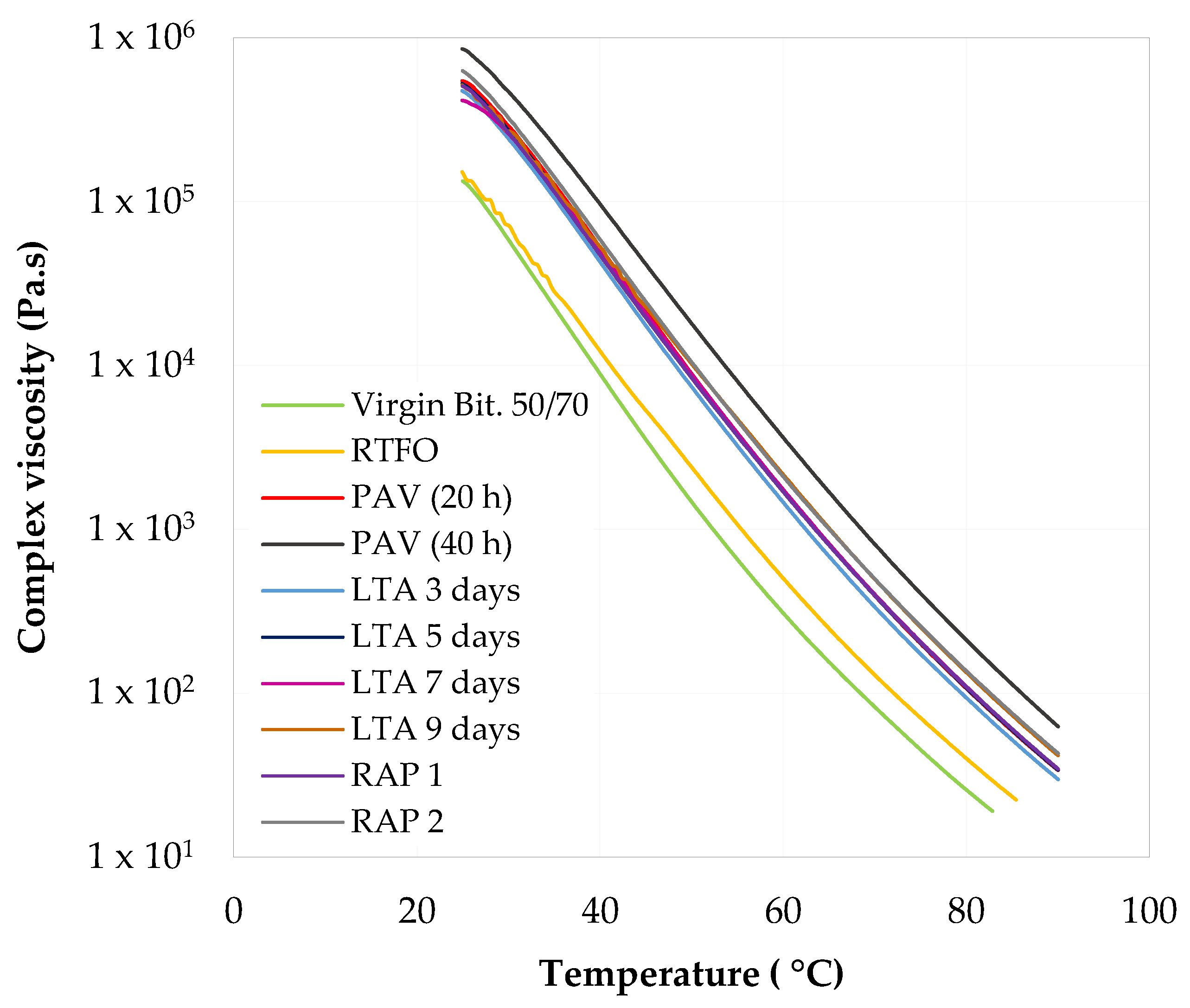
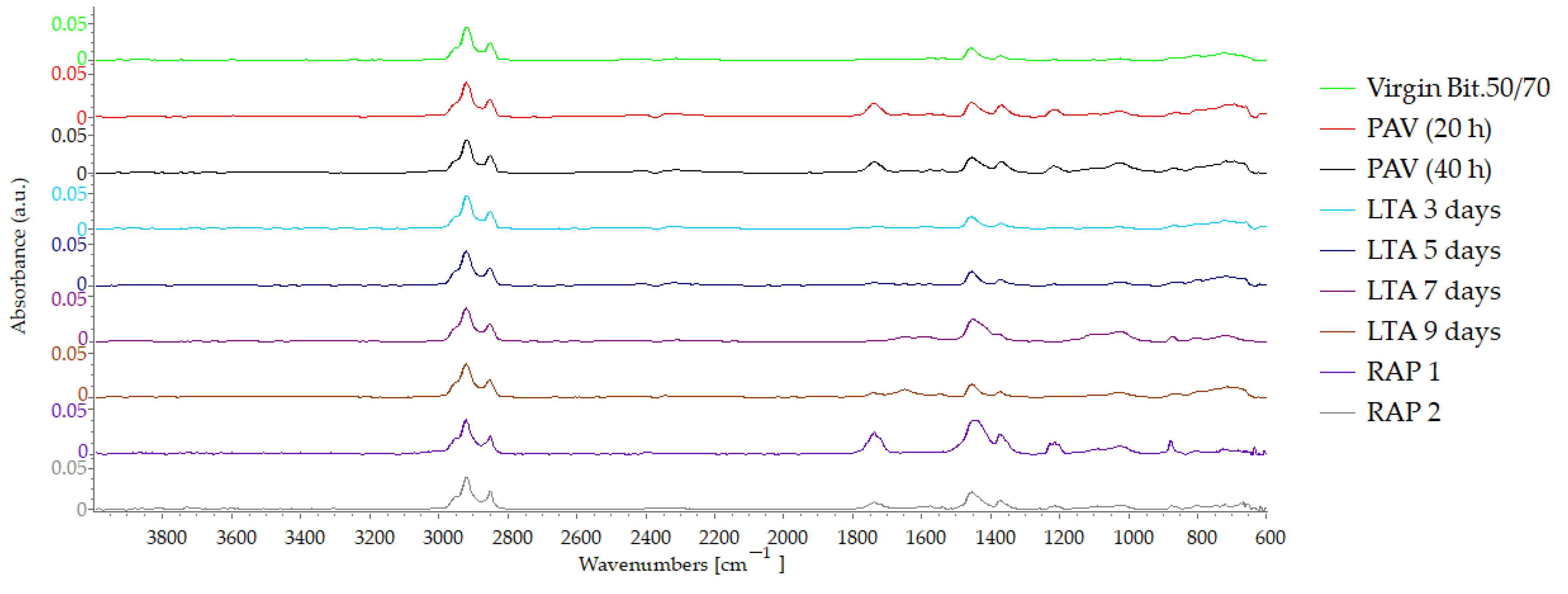
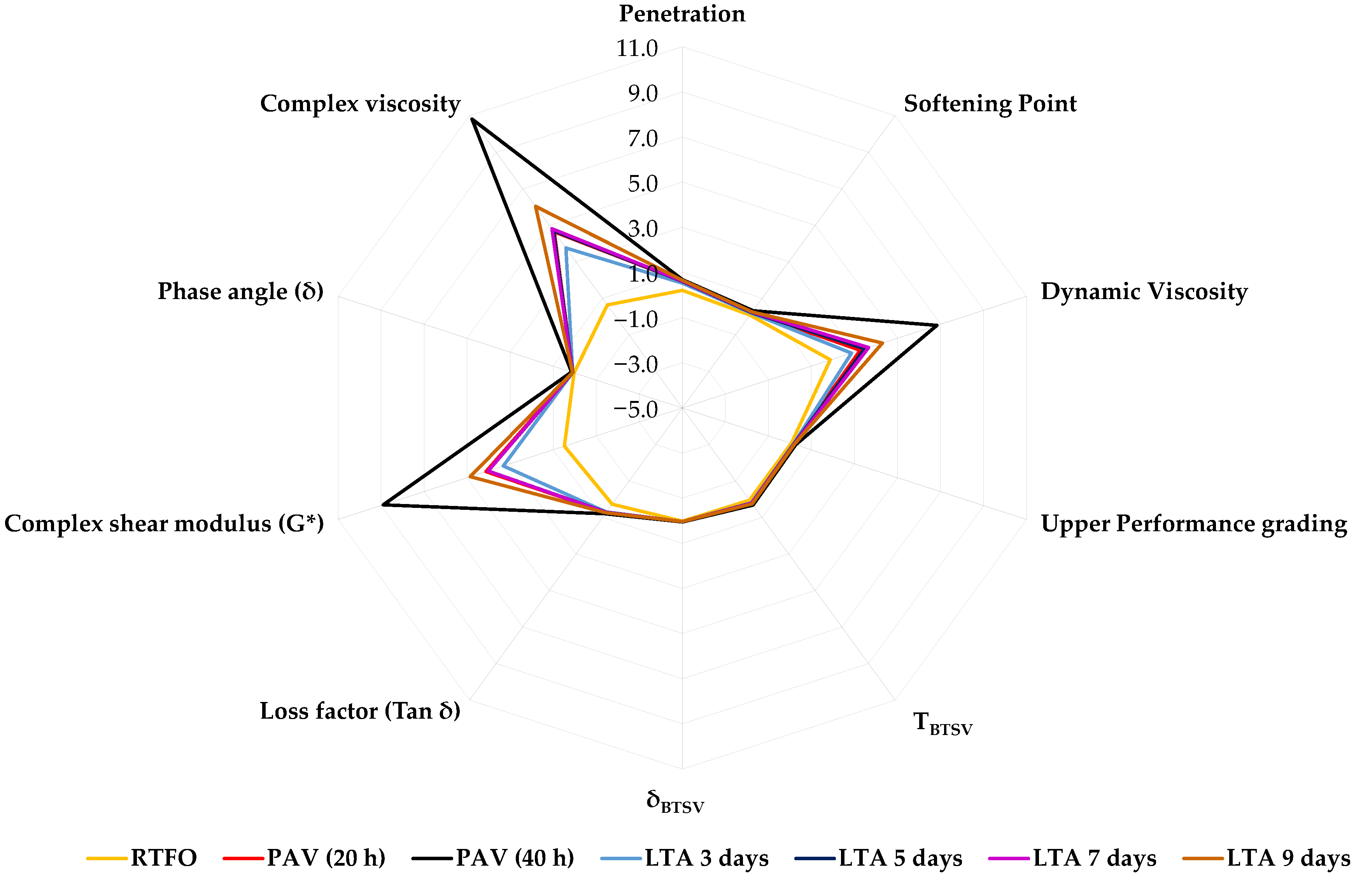
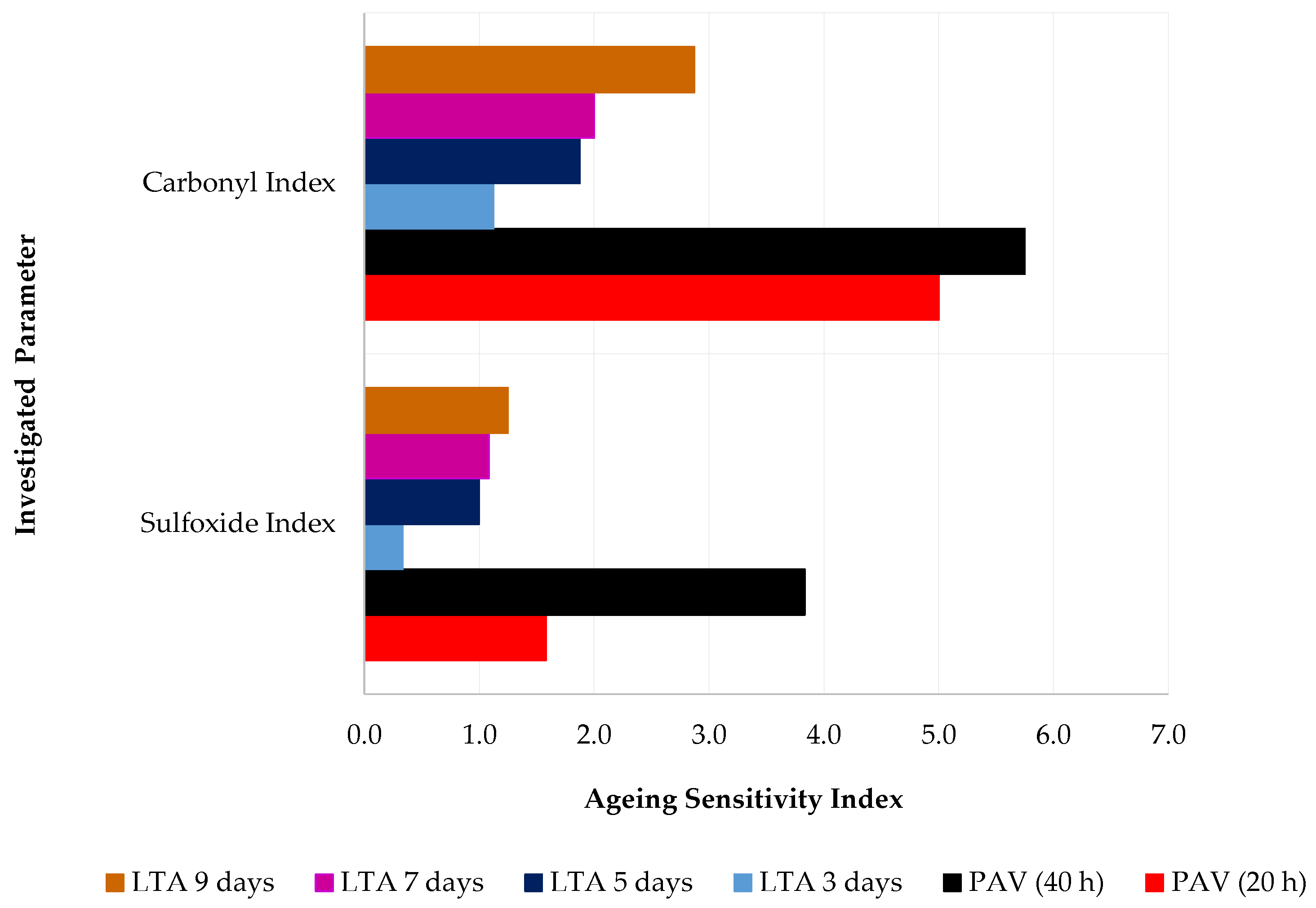
| Sieve Size (mm) | Passing Percent (%) | |
|---|---|---|
| Optimised Mix Gradation | Specification Limits | |
| 16 | 100 | 100–100 |
| 12.5 | 100 | 100–100 |
| 8 | 95.3 | 90–100 |
| 4 | 53.9 | 44–64 |
| 2 | 32.6 | 28–42 |
| 0.5 | 20.6 | 12–24 |
| 0.25 | 16.4 | 8–18 |
| 0.063 | 8.1 | 6–10 |
| Binder | Original Upper PG (°C) | Upper Critical Temperature (°C) |
|---|---|---|
| Virgin Bit. 50/70 | 64 | 67.5 |
| RTFO | 70 | 72.0 |
| PAV (20 h) | 76 | 80.1 |
| PAV (40 h) | 82 | 85.2 |
| LTA 3 days | 76 | 78.4 |
| LTA 5 days | 76 | 80.0 |
| LTA 7 days | 76 | 80.6 |
| LTA 9 days | 76 | 81.8 |
| RAP 1 | 76 | 80.9 |
| RAP 2 | 82 | 82.4 |
| Binder | TBTSV (°C) | δBTSV (°) |
|---|---|---|
| Virgin Bit. 50/70 | 49.9 | 85.3 |
| RTFO | 52.9 | 83.9 |
| PAV (20 h) | 61.0 | 81.9 |
| PAV (40 h) | 65.8 | 80.6 |
| LTA 3 days | 59.8 | 82.3 |
| LTA 5 days | 60.9 | 81.9 |
| LTA 7 days | 61.4 | 81.8 |
| LTA 9 days | 62.4 | 81.6 |
| RAP 1 | 61.5 | 81.7 |
| RAP 2 | 62.3 | 81.5 |
| Binder | Sulfoxide Index (SI) | Carbonyl Index (CI) |
|---|---|---|
| Virgin Bit. 50/70 | 0.12 | 0.08 |
| PAV (20 h) | 0.31 | 0.48 |
| PAV (40 h) | 0.58 | 0.54 |
| LTA 3 days | 0.20 | 0.17 |
| LTA 5 days | 0.24 | 0.23 |
| LTA 7 days | 0.25 | 0.26 |
| LTA 9 days | 0.27 | 0.31 |
| RAP 1 | 0.24 | 0.45 |
| RAP 2 | 0.27 | 0.40 |
Disclaimer/Publisher’s Note: The statements, opinions and data contained in all publications are solely those of the individual author(s) and contributor(s) and not of MDPI and/or the editor(s). MDPI and/or the editor(s) disclaim responsibility for any injury to people or property resulting from any ideas, methods, instructions or products referred to in the content. |
© 2023 by the authors. Licensee MDPI, Basel, Switzerland. This article is an open access article distributed under the terms and conditions of the Creative Commons Attribution (CC BY) license (https://creativecommons.org/licenses/by/4.0/).
Share and Cite
Vijayan, V.; Mantalovas, K.; Acuto, F.; Di Mino, G. Evaluating the Ageing Sensitivity of the Asphalt Binder via Distinct Ageing Methods. Infrastructures 2023, 8, 163. https://doi.org/10.3390/infrastructures8110163
Vijayan V, Mantalovas K, Acuto F, Di Mino G. Evaluating the Ageing Sensitivity of the Asphalt Binder via Distinct Ageing Methods. Infrastructures. 2023; 8(11):163. https://doi.org/10.3390/infrastructures8110163
Chicago/Turabian StyleVijayan, Vineesh, Konstantinos Mantalovas, Francesco Acuto, and Gaetano Di Mino. 2023. "Evaluating the Ageing Sensitivity of the Asphalt Binder via Distinct Ageing Methods" Infrastructures 8, no. 11: 163. https://doi.org/10.3390/infrastructures8110163
APA StyleVijayan, V., Mantalovas, K., Acuto, F., & Di Mino, G. (2023). Evaluating the Ageing Sensitivity of the Asphalt Binder via Distinct Ageing Methods. Infrastructures, 8(11), 163. https://doi.org/10.3390/infrastructures8110163








